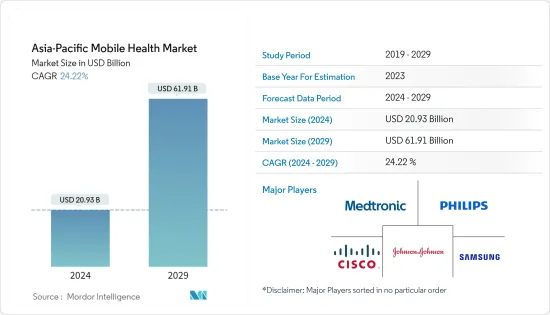PUBLISHER: Mordor Intelligence | PRODUCT CODE: 1432436

PUBLISHER: Mordor Intelligence | PRODUCT CODE: 1432436
Asia-Pacific Mobile Health - Market Share Analysis, Industry Trends & Statistics, Growth Forecasts (2024 - 2029)
The Asia-Pacific Mobile Health Market size is estimated at USD 20.93 billion in 2024, and is expected to reach USD 61.91 billion by 2029, growing at a CAGR of 24.22% during the forecast period (2024-2029).

The use of mobile devices by healthcare professionals has transformed many aspects of clinical practice in the Asia-Pacific region. It has led to the rapid growth in the development of medical software applications (apps) for these platforms.
Mobile devices and apps provide many benefits for healthcare professionals, most significantly the increased access to point-of-care tools, to support better clinical decision making and improved patient outcomes.
Moreover, factors such as increased awareness levels among the people, about the potential benefits of healthcare management, increased need of point-of-care diagnosis and treatment, and increasing focus on personalized medicine and patient-centered approach, are driving the growth of the mobile health market.
In addition, the rapid technological advancements in mHealth research generate both opportunities and challenges, including creating scalable systems that are capable of collecting unprecedented amounts of data and conducting interventions, while protecting the privacy and safety of the research participants. Additionally, the stringent regulatory policies for mHealth applications are expected to restrain the market's growth.
Asia-Pacific Mobile Health Market Trends
Neurological Monitors are Expected to Register a High Growth Rate Over the Forecast Period
Neurological monitors mainly utilize brain wave activity, namely, the electroencephalogram (EEG). The constituent components of the neurological monitor are the electrodes, amplifiers, analog-to-digital converter (ADC), and the monitoring display. Neurological diagnostic monitoring is accomplished using quantitative EEG analysis for assessment of the ongoing brain activity.
Neurological monitoring is very important, especially in case of pateints with neurological diseases like dementia. Dementia is highly prevalent in the elderly population. As per reports by the United Nations, Asia-Pacific counties like Japan, China and Australia have very high percentage of population aged 60 years or above and is further expected to increase in future as well. This is expected to increase the incidence of neurological illnesses in the region, which will increase the demand for neurological monitoring devices. This will help the market growth in the region.
Asia-Pacific Mobile Health Industry Overview
Most of the countries in the Asia-Pacific region are developing economies. These developing economies have high numbers of people with unattended neurological conditions and diseases. As a result, these countries have high potential for mobile and remote care, and hence, are highly lucrative for the global players to enter. Moreover, some regional players have established their presence in the region.
Additional Benefits:
- The market estimate (ME) sheet in Excel format
- 3 months of analyst support
TABLE OF CONTENTS
1 INTRODUCTION
- 1.1 Study Deliverables
- 1.2 Study Assumptions
- 1.3 Scope of the Study
2 RESEARCH METHODOLOGY
3 EXECUTIVE SUMMARY
4 MARKET DYNAMICS
- 4.1 Market Overview
- 4.2 Market Drivers
- 4.2.1 Increasing Usage of Smartphones, Tablets, and Mobile Technology in Healthcare
- 4.2.2 Increased Need for Point-of-care Diagnosis and Treatment
- 4.3 Market Restraints
- 4.3.1 Data Security Issues
- 4.3.2 Stringent Regulatory Policies for mHealth Applications
- 4.4 Porter's Five Forces Analysis
- 4.4.1 Threat of New Entrants
- 4.4.2 Bargaining Power of Buyers/Consumers
- 4.4.3 Bargaining Power of Suppliers
- 4.4.4 Threat of Substitute Products
- 4.4.5 Intensity of Competitive Rivalry
5 MARKET SEGMENTATION
- 5.1 By Service Type
- 5.1.1 Monitoring Services
- 5.1.2 Diagnostic Services
- 5.1.3 Treatment Services
- 5.1.4 Wellness and Fitness Solutions
- 5.1.5 Other Service Types
- 5.2 By Device Type
- 5.2.1 Blood Glucose Monitors
- 5.2.2 Cardiac Monitors
- 5.2.3 Hemodynamic Monitors
- 5.2.4 Neurological Monitors
- 5.2.5 Respiratory Monitors
- 5.2.6 Body and Temperature Monitors
- 5.2.7 Remote Patient Monitoring Devices
- 5.2.8 Other Device Types
- 5.3 By Stakeholder
- 5.3.1 Mobile Operators
- 5.3.2 Healthcare Providers
- 5.3.3 Application/Content Players
- 5.3.4 Other Stakeholders
- 5.4 By Geography
- 5.4.1 Asia-Pacific
- 5.4.1.1 China
- 5.4.1.2 Japan
- 5.4.1.3 India
- 5.4.1.4 Australia
- 5.4.1.5 South Korea
- 5.4.1.6 Rest of Asia-Pacific
- 5.4.1 Asia-Pacific
6 COMPETITIVE LANDSCAPE
- 6.1 Company Profiles
- 6.1.1 AT&T Inc.
- 6.1.2 Bayer Healthcare
- 6.1.3 Cerner Corporation
- 6.1.4 Cisco Systems Inc.
- 6.1.5 Johnson & Johnson
- 6.1.6 Medtronic PLC
- 6.1.7 Omron Corporation
- 6.1.8 Philips Healthcare
- 6.1.9 Qualcomm Life
- 6.1.10 Samsung Healthcare Solutions
7 MARKET OPPORTUNITIES AND FUTURE TRENDS




